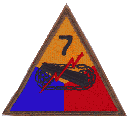

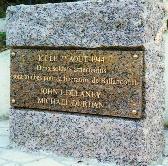
The Erroneous Monument
The monument inscription is unfortunately doubly in error. The records at the time the men were killed are clear, explicit, unambigouous and unanimous. These men died August 23 just west of Farcy, about 12 miles east of Ballancourt. In fact, they never even passed through Ballancourt on the way to Farcy. Nevertheless, two soldiers were killed near Ballancourt and brought into the town by civilians, wishing to honor them. So how has there been confusion that led to the belief that Delaney and Durdan died August 22 at Ballancourt? And if they were not the liberators of Ballancourt, then who were the men killed and honored by the French? This web page examines each of these issues and provides solid documentation, as much as it is known at this time.
There are quite good records, created at the time that the men were killed, by their battalion and battery. The records are clear and explicit in giving the details of how they died and where they died and when they died. There is no uncertainty, no ambiguity: the records all tell the same story, some in more detail and some in less.
1a. Morning Reports of Battery "B"
The Morning Reports were turned in each morning showing the battery's prior-day (1) personnel status changes, (2) location as of 2400, (3) strength counts, and (4) occasional "Record of Events" entries, giving the details of what the battery had done that day. These are the only documents that survive at the battery level. All other documents are at the battalion level or higher. The Morning Reports were the first record to give the official report of the deaths of the two men.
Frequently, specific personnel events -- primarily MIA (Missing in Action), sometimes KIA (Killed in Action) and promotions and transfers into or out of the battery, appeared as delayed retroactive entries on the Morning Reports a few days after the event. This was the case with the report of the deaths of John Delaney and Michael Durdan. The following image is the upper part of the B/440 Morning Report of August 27, 1944, showing the two men has having been Killed in Action on August 23.
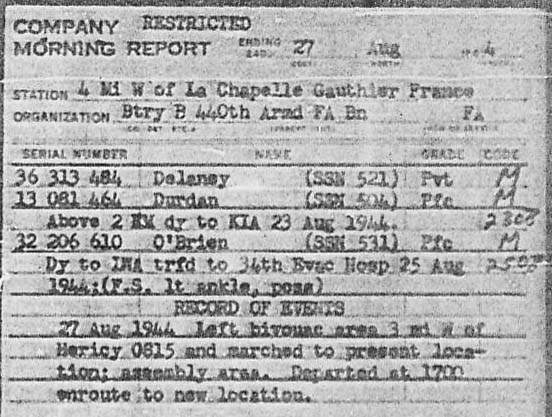
The date of their death is thus clearly established. The next question is where they were on August 23. The B/440 Morning Report makes that clear also. As shown below, the battalion began the day just west of Farcy, France. They were hit by enemy counter-battery artillery fire and then moved 3 miles west of Farcy, a location from which they could support the troops of 7th Armored Division but which would place them further from enemy observation and from enemy artillery. Note the precise time at which they left their first location (1830) and at which they arrived at the final location (1900).
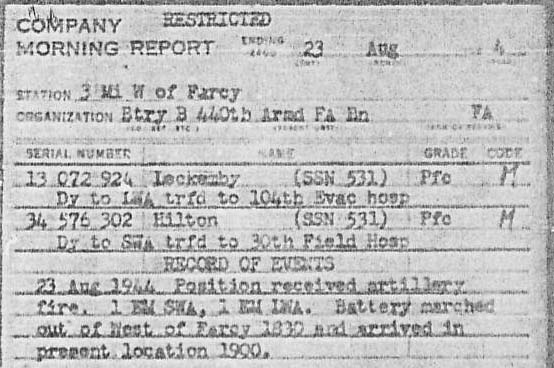
And precisely where is Farcy? And how close is it to Ballancourt? The following map has the two locations circled. Farcy is about 12 miles (20 kilometers) east of Ballancourt.

And for the sake of completeness, where was the battery on August 22? Could they possibly have gone through Ballancourt that day? The August 22 B/440 Morning Report shows the following:
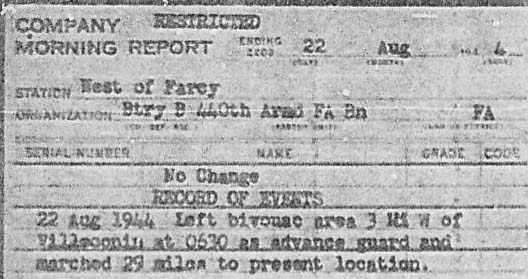
This is inconclusive. Villeconin is west of Ballancourt, so that it might have been possible for the battery to have traveled through Ballancourt. As we will see with other documents, this was not in fact the case: the men of B/440 never were in Ballancourt on August 22 nor any other date.
The fact that the battery was part of the advance guard is very unusual for an artillery battery. As we will see later, however, even the advance guard would not have been the first to arrive in the towns along their route, since they were preceded by an augmented cavalry reconnaissance troop.
Summary from Morning Reports
When were they killed? August 23, 1944
Where were they killed? just west of Farcy, France
How were they killed? by artillery fire
Were they ever at Ballancourt? inconclusive
1b. Unit History of 440th Armored Field Artillery Battalion
The S-3 (Operations) and S-2 (Intelligence) Officers kept daily journals for their battalions. These journals were attached to a narrative After Action Report that was submitted through channels to Washington, D.C. In some battalions, these marratives were referred to as Unit History reports. That was the case for 440 AFAB. For 22-23 August 1944, they provide the following account:
|
The 440th suffered its first loss on 22 August, in the village of Soisy Sur Ecoles. There, during a brief halt, Private Antonio Annaiballi ASN 31l32476, Service Battery, was killed instantly by sniper fire. The same day Battery B fired a concentration on enemy machine guns and anti-tank guns and an hour later, at 2100, the battalion went into bivouac 2 miles south of its objective, Melun. From this point the battalion delivered its first night concentration: 20 minutes of preparatory fire. This was followed by another concentration at dawn. Harrassing fire struck the area during the morning, but no casualties resulted. The 695 Armored F. A. Battalion was attatched to the 440th in the course of the day, with the 177th in support with its 155 guns. Two more men were lost in the day's action (23 August). Heavy counter battery at 1640 resulted in the death of Private John F. Delaney (ASN 36313484) and PFC Michael Durdan (ASN 13081464). Both were members of Battery B. Four men were wounded slightly. |
Once again, a clear and explicit report states that the two men were killed August 23 by artillery fire. Rather than Farcy, the location is specified as "2 miles south of" Melun, which is where they would have been if they were in the vicinity of Farcy.
Note that the time of the counter=battery artillery is precisely given (1640), which was a bit less than 2 hours before the surviving men of B/440 moved to a new position, 3 miles further west.
But does the report support or refute them being in Ballancourt at any time? It does indicate that a memver of Service Battery, which would have been one of the trailing elements of the column (and not in the advance guard), was killed at Soisy-sur-Ecoles. So it is likely that the entire battalion passed through Soisy-sur-Ecoles. Soisy-sur-Ecoles is about 10 road miles from Ballancourt, but there are no roads of the quality that the column would have used. If they had gone through Ballancourt, then they would have to either go east and then south or south and then east. So this question is still inconclusive. But the fact that the battalion went through Soisy does tell us that they did not go from Villeconin to Farcy on the direct route through Ballancourt. At some point, they went south. The only question is whether they did so before reaching Ballancourt (and thus not going through Ballancourt) or after reaching Ballancourt. As other record show below, the former was the case.
Summary from Unit History Report
So all three key questions are answered in the same way as they were in the Morning Reports:
When were they killed? August 23, 1944
Where were they killed? 2 miles south of Melun, France (thus Farcy area)
How were they killed? by artillery fire
Were they ever at Ballancourt? inconclusive
1c. After Action Report of 17th Tank Battalion
The advance guard of Combat Command R's column, which was the combat command to which 440 AFAB was attached for the march to Melun, was commanded by Maj. Thomas Dailey of 17th Tank Battalion. B/440 was part of that advance guard. Thus the 17th Tank Battalion After Action Report record of the route of the advance guard can finally answer the question of whether B/440 -- and more precisely John Delaney and Michael Durdan -- were ever in Ballancourt on August 22.
Here is the 17th Tank Battalion After Action Report account of the advance guard movement on August 22, 1944, up to the point where they have definitely bypassed Ballancourt on a more southern route. (Paragraph breaks are inserted to make the text easier to follow. The original was one long paragraph followed by what is here the final paragraph.)
|
At 0600, 22 Aug 44, the advance guard, still under command of Major Dailey, moved out of the assembly area to continue the mission to Melun. The advance continued rather slowly with our advance guard right behind the rcn element and being stopped continuously because the rcn element could not advance fast enough. At 0900 our unit was in Velleconin. At 0945 the rcn element reported that two A.T. guns were holding up the advance. Prior to this time Major Dailey had attached one platoon of medium tanks to the 87th Rcn Company who was in front of the advance guard to support the rcn company. This support platoon was from Company "A" of the 17th Tank Bn and was commanded by Lt Carpenter. At 1030 the main body reached Chauffour-Les-Etrechy. At 1105 forward elements reported enemy tanks and Tank Destroyers were requested to come forward. At 1100 the Commanding General of the 7th Armd Div ordered CCR to push ahead vigorously and to use artillery if necessary. At 1125 the tanks who were supporting the rcn encountered some dismounted enemy infantry and fired on them. At 1125 the Commanding General ordered that the Command form multiple columns and push ahead. At 1135 Lt Carpenter's medium tank platoon reported that the dismounted resistance had been wiped out. From this point Lt Carpenter with his medium tank platoon preceded the 87th Rcn company in other words he continued the advance without any rcn in front of him. The main body passed through Villeneuve-sur-Auvers at 1210. At this time the point of the advance guard was past the town of Boissy-le-Cutte. Lt Carpenter's platoon supported by one platoon from Company "C" of the 17th Tank Bn knocked out one A.T. gun in vicinity of La Ferte Alais. At 1235 the point composed of Lt Carpenter and the element from Company "C" knocked out one German car and at 1240 the point knocked out 3 A.T. guns, killing at least 15 Germans and also knocked out a truck. The advance through La Ferte Alais was continued rapidly and at [time not given] Lt Carpenter reported that he took the wrong route in La Ferte Alais and while on the wrong route knocked out 5 A.T. guns and at least 40 Germans. Lt Carpenter was back on the correct route by 1315 and reported that in addition to the A.T. guns, two German automobiles had been knocked out. The main body was in Cerny at 1322 and Montmirault at 1325 and passed through La Ferte Alais at 1400. The main body received machine gun fire and rifle fire from dismounted troops along Highway GC 83 just out of La Ferte Alais, however, no one was hurt. Lt Carpenter and Captain George, who commands Company "C" of the 17th Tank Bn, as well as all of the men in Lt Carpenter's platoon and Captain George's Company, did a brilliant job in pushing through the resistance at La Ferte Alais and their work was recognized and appreciated by everyone who had knowledge of it. During this encounter with the enemy the 17th Tank Bn did not have any casualties. The point drew some fire in Soisy but they sprayed the position with machine gun fire and continued on the mission. The Infantry also drew fire and returned it in Soisy and estimated the enemy strength at 40 men. |
It should be kept in mind that routes were very carefully allocated to different columns, so that they would not cross each others' paths and either accidentally fire on each other or else create a traffic jam so that neither column could move forward. So there would have been no diverging from the column's route and ending up in Ballancourt when the rest of the column was going on a different route: the entire column traveled the same route. And if there were troops going through Ballancourt, they would be from a different column.
So it is possible to plot out the route that A/17 and the 87 Recon and the advance guard followed. And it does not go through Ballancourt but instead goes well to the south.

So the closest that they came to Ballancourt was about 4.5 miles (7.5 kilometers) to the south.
1d. Records of Other Units
Troop B, 87th Cavalry Reconnaissance Squadron, was the reconnaissance troop ahead of CCR's advance guard. The B/87 Morning Reports have no detail of the march.
The Division Artillery After Action Report gives a colorful account of CCR's August 22 march, which while it adds no new details to the questions at hand does help to understand what the advance guard encountered:
|
CCR had been directed to reach Melun by 1500 the afternoon of the 22nd. The advance guard met resistance most of the way and after the loss of several light tanks of the reconnaissance unit, was forced to literally roll its way across all opposition. This it proceded to do by the use of medium tanks and a platoon of Tank Destroyers (M-10). German vehicles and personnel littered the road side as blazing machine guns and tank gun fire supported by a battery of 105 SP (M-7) and the T/D's, destroyed anything that might hinder the columns progress. |
1e. Were Delaney and Durdan's remains evacuated to or through Ballancourt?
The remains of men killed anywhere in the Division area were evacuated to designated collecting points, operated by Division Trains. Is it possible that John Delaney and Michael Durdan's remains were evacuated to or through Ballancourt, so that where they never were in life they may have been after they had died?
The Individual Deceased Personnel Files of Delaney and Durdan show that their remains were recovered from Melun and taken to the temporary U. S. Military Cemetery at Villeneuve-sur-Auvers, where they were buried at 5 PM on August 25. The most direct route on good roads from Melun to the cemetery would have been to Ballancourt and then along the southwestern edge of town and on to Villeneuve. So it does seem likely that their remains did travel to the outskirts of Ballancourt, but only inside of vehicles that were passing through. They were never taken into the town center by the French citizens on August 22 or any other day.
I can only speculate about this question, but I believe that there is a reasonable answer.
The two known facts are:
But there is a third fact that is also known. That is the fact that, once Ballancourt was a peaceful area, after the war had ended, the 106th Reinforcement Battalion set up a station at Ballancourt, in late July 1945. And they created a recreational field (possibly in conjunction with the first August 22, 1945 anniversary of the liberation of Ballancourt) that they named in honor of John Delaney. Thus this unit of the U. S. Army may have inadvertently created the false impression that Delaney had been killed at Ballancourt. If the U. S. Army said so, then the French citizens must assume that it was so. However, the unit that created the recreational field had nothing to do with 7th Armored Division, had not been at Ballancourt during the combat more than a year earlier, and they were obviously not aware of where Delaney had really died if they did in fact state that he died at Ballancourt. But they may never have stated that; the sign on the field certainly makes no such claim. Even if it was never stated, it was still an impression that apparently had the imprimatur of the U. S. Army, and the impression was then turned into fact at some point. We will probably never know who it was in the 106th Reinforcement Battalion who chose to name the field after John Delaney, nor what he stated, nor what he knew about Delaney's death. But it does seem highly likely that this field honoring John Delaney somehow morphed into a belief that John Delaney had been killed at Ballancourt.
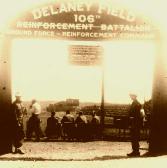 Pvt. John F. Delaney Field Inscription on Sign over Entrance: In loving and grateful memory of Pvt. John F. Delaney U.S. Army 7th Armored Division He gave his life. He gave his soul. Be blest that freedom loving people may rest. To him we dedicate this field. For liberty and freedom he was our shield. (Photo taken August 11, 1945 By Albert Fisher; supplied by Al Wilderspin, nephew of John Delaney) |
I have found very little about the 106th Reinforcement Battalion. The one internet mention is here, where there is the single sentence "We left Marxzell, Germany July 20, 1945 by 40 x 8 [railroad cars] for the 19th Reinforcement Depot, 106th Reinforcement Battalion 504th Company near Paris, France."
It is not clear whether the Ballancourt station was the battalion headquarters, but there is no mention of any company on the sign, so that it seems that it may have been the headquarters.
The key fact is that, by August 1945, someone had associated John Delaney's death with Ballancourt, by naming the field after him. The reason that person had for associating Delaney with Ballancourt is not known. Did they wish to choose someone who had died near their station and learned that Delaney had died only 12 miles away? Was this the first time this associaiton had been made, or had someone in the town told them that Delaney had died at Ballancourt? Had Delaney's remains been brought to Ballancourt from Farcy? The questions cannot be answered from the records available.
The bottom line is that the association had been made in or before August 1945.
But there are two errors on the monument: (1) the placement of the deaths of Delaney and Durdan at a location in Ballancourt instead of their actual location just west of Farcy and (2) the placement of their deaths on August 22 instead of their actual date of death on August 23. The association made in 1945 explains the first but not the second error. That is, the field either continued or began the confusion of the location of the deaths of the men. But had the confusion of their date of death also happened by August 1945, or did that confusion come about as an expansion of the confusion of the location? If the citizens of Ballancourt understood that the authority of the U. S. Army had decided that the men had died at Ballancourt, then it was only logical to assume that they must have died there on August 22 during the liberation of Ballancourt, since there was no longer any fighting once the town had been liberated. Is this the sequence of events that led to the confusion of the dates, or had that confusion also preceded the naming of the field for John Delaney? Once again, these questions cannot be answered from the records available.
There may have been yet further confusion expanding from these earlier confusions. When Al Wilderspin, nephew of John Delaney, contacted me, he had heard about or read a local newspaper article in their hometown, in which a journalist had concocted a story of John Delaney crawling on his belly and throwing a grenade in his dieing act in the liberation of Ballancourt. Al did not have the article, and I have not been able to find it. But clearly Al had come away with a vivid story that the article had told. Such journalists are the bane of history: their editors made it clear that the hournalist's job was to make their article seem like the most important thing that could possibly have happened in the world, and that meant that the facts could be twisted, contorted, or simply manufactured out of thin air to enable them to write such articles. The newspaper articles about World War II are full of such stuff, and modern journalists naturally turn to their predecesors as sources of "facts" for their own most-important-thing-in-the-world articles, thus regurgitating these same twists, contortions and fabrications as if they were facts and presenting them as "history". It is a rare journalist who actually does good quality research and writes a truly accurate article about World War II. That was true during and after the war, and it remains true today. The way in which the men died is very explicitly and clearly stated in the documentation of their death by their comrades: they were killed by counter-battery artillery fire.
In the 1990's Mrs. Odette Pantelich sought to honor the two unknown men who were honored on a monument at Ballancourt. She had been nearby at the time the men were killed, and she wanted to know who those men were. So she sought the names of those men. And whatever the process was that had led to the naming of the recreational field was apparently accepted by those whom she contacted: she was given the names of John Delaney and Michael Durdan. During the past 15 years, a great many records -- many of them personnel records such as the Individual Deceased Personnel Files and the Morning Reports -- have been gathered that her informants did not have in the mid 1990's. They gave the best answer that they could with the information that they had. But now we know that they gave her the names of the wrong men. So now it is time, with the much greater archive that we now have, to answer her question, which is the third question of this report.
This is a more difficult question to answer. The movement of the CCR column was very well documented, partly because of which units were in the column (17th Tank Battalion documentation tends to be excellent) and partly because the column met so much German resistance. But it was not the only column of 7th Armored Division moving to the Seine River on August 22. Some American soldiers were the first to enter Ballancourt at some point. But what unit was the first to arrive at Ballancourt and thus to merit recognition as the liberators of Ballancourt? Was there any combat at Ballancourt, or did the 7th Armored Division columns bypass Ballancourt on other routes, so that the first Americans to arrive there were from rear echelon units?
XX Corps Field Order #6, issued at 2115 on August 20, which gave the overall plan for the move to this part of the Seine River placed Ballancourt on the 7th Armored Division axis of signal communications (paragraph 5b), so that it was clearly a 7th Armored Division unit that would have been the first to arrive in Ballancourt:
|
b. Ax of Sig Corn
|
7th Armored Division moved from Dreux to Melun in three columns, one for each combat command (A, B, R). Combat Commands A and R arrived in the Melun area August 22. CCB came behind on August 23. Since we know the route of CCR on August 22, it is now necessary to establish the route of CCA, in order to determine if CCA came through Ballancourt on August 22.
CCA moved on a route further north than CCR. That is clear from the CCA After Action Report:
|
Attacked Arpajon 0800 22 Aug 44. Command moved on the 22d Aug 44 after successful attack and met with intermittent resistance by AT guns and 88-mm. Resistance was put down with light losses and command moved to 1/2 mile S Ponthierry. |
The After Action Report of 87th Cavalry Reconnaissance Squadron adds a bit more information but no new locations:
|
Squadron Headquarters followed Troop "D" preceeding CCA to the vicinity of Arpajon, and came under artillery fire just short of that town. As the situation developed, the Combat Commander decided upon a morning attack. When the attack was launched on the morning of 22nd, it was found that the enemy had moved out during the night. Troop "A" bypassed Arpajon to the North, and the remainder of the Squadron followed CCA through Arpajon and on to Ponthiery where a bivouac was established shortly after midnight. |
40th Tank Battalion was the tank battalion assigned to CCA. But the 40th Tank Battalion After Action Report is equally imprecise, also failing to tell the route by which they moved from Arpajon to Ponthierry.
|
Left this bivouac area at 0900, 22 August 44 marching about 2 miles. Our vehicles were extended into battle line over a cultivated field and advanced on the town of Arpajon, France. Contacted enemy who was in this town an 1030. Engaging small enemy troops at times until 1300. The town was cleared of enemy troops at 1315, 22 August 44. Our vehicles had a little hard going over the cultivated land due to the rain of the night before. Marched through town at 1400 to an area about 2 miles west of the town. Serviced our vehicles and guns and ate our noon meal. On checking personnel and vehicles, it was found we had suffered no loss. Left this temporary assembly area at 1700, 22 August 44 and contacted enemy at 1800 at Ponthierry, France. |
48th Armored Infantry Battalion was the infantry battalion assigned to CCA. But the 48 AIB After Action Report again makes no mention of how the column moved from Arpajon to Ponthierry. However, what is becoming clear is that if the column did go through Ballancourt, it was apparently without any German opposition.
|
Early on the morning of the 22nd, and concealed in a dense fog which reduced visibility to a matter of a few feet, not yards, the advance elements moved on the town [Arpajon]. Fortunately, the major portion of the garrison had fled during the night. The push continued throughout the day and evening and almost at midnight, after a sharp skirmish which resulted in the loss to the Germans of a fuel convoy, the unit bivouaced 5 miles East of Ponthierry on the Seine. |
489th Armored Field Artiller Battalion was the artillery battalion assigned to CCA. The 489 AFAB After Action Report provides no further locations along the route, although it does show their destination as Jonville. But it does give the order of march for the column.
|
22 Aug 44
|
Summary from CCA records: None of the elements of CCA tell how they moved from Arpajon to Ponthierry. It is known that a reconnaissance jeep of Headquarters Company of 40th Tank Battalion hit a mine in Echarcon, while fleeing from Germans guarding the bridge over the Essone. This was apparently the end of the consideration of using that bridge to cross the Essone. Considering the roads of that period, the preferred route to reach Ponthierry from Arpajon would be through Ballancourt, where the Essone would be crossed. Taking this and the axis of signal communication dictated in the XX Corps General Orders that included Ballancourt, it seems highly likely that CCA moved to Ponthierry via Ballancourt. But their passage through Ballancourt was either completely uneventful or with events of only a minor nature that did not merit being reported in any of the after action reports. So it does not appear that there was any combat at Ballancourt: the town was liberated simply by the arrival of American troops unopposed.
The following day, August 23, Combat Command B followed CCA, apparently along the route that CCA had used. And the CCB and 434th AFAB reports are very specific about their route, which did indeed include Ballancourt:
|
CCB After Action Report - 23 August 1944
434 AFAB Record of Operations - 23 August 1944
|
Breakthrough with the Company Records: All of the After Action Reports were at the battalion level or higher. Each battalion had several companies, and their records appear in their Morning Reports --gathered over the past 15 years through considerable effort that is still continuing -- and not in any After Action Reports or journals. The problem was that there were so many companies to consider that it was difficult to determine the best possible candidates. However, Richard Reed, a friend of Mrs. Odette Pantelich, read the first version of this web page and recognized that it was worth considering the 48th Armored Infantry Battalion. So he examined the web page of 48 AIB's dead and found that two men from Company C, Pfc. John W. Singleton and Pvt. Salvatore Grifo, had indeed been killed August 22, 1944. I then examined the Morning Reports of C/48 and also of D/87, the troop of the 87th Cavalry Reconnaissance Squadron that was the only other likely candidate unit. And it was suddenly very clear that Singleton and Grifo were indeed the right men.
Here are the morning reports for August 22 of C/48 and D/87.
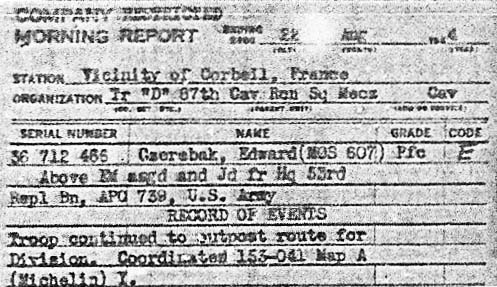
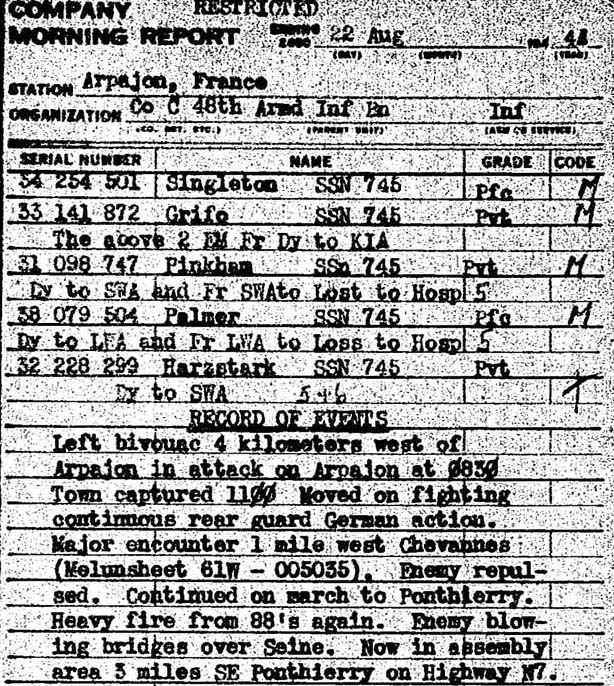
It is very clear that D/87 saw no action at all as they moved. Possibly they may have been on the flanks of the advancing units, acting as liaison between them in order to avoid friendly fire and to keep the columns from moving into each others' paths, rather than leading out ahead of the advancing columns.
And it is also very clear that C/48's "major encounter" 1 mile west of Chevannes was precisely on the outskirts of Ballancourt, as C/48 sought to bypass Ballancourt and drive on to Chevannes ... this is right where the monument now stands. And Singleton and Grifo are the men who were killed there. (The three men who were wounded all survived. Pinkham and Harzstark were both SWA = Seriously Wounded in Action, which meant that their wounds were considered to be life-threatening. Palmer was LWA = Lightly Wounded in Action.)
Conclusions
The men who were killed at or near the place of the Ballancourt monument were Pfc. John W. Singleton of Haywood County, North Carolina and Pvt. Salvatore Grifo of Easton, Pennsylvania. Both were members of Company C, 48th Armored Infantry Battalion, 7th Armored Division, which deserves the credit as the unit that drove the last Germans from the Ballancourt area. It appears that C/48 circled around the north and east of Ballancourt, with the objective of moving to Chevannes, and did not go through the main part of the town of Ballancourt.
Active overview of all pages at the 7th Armored Division web site